Research on the Mechanism and Application of High Pre-Tension on the Crack-Arresting Effect of Rockbolt Anchorage
Abstract
1. Introduction
2. Engineering Profile
2.1. Engineering Background
2.2. Analysis of Peeping Results
2.3. Current Issues
3. Theoretical Analysis of Crack-Arresting Effect of Prestressed Rockbolts
3.1. Stress Intensity Factor Model for Cracks in Anchored Surrounding Rock
3.2. Expression for the Stress Intensity Factor of Cracks under Axial Force of Rockbolt
3.3. Influence Mechanism of Pre-Tension on Crack Stress Intensity Factor
4. Numerical Analysis of the Crack-Arresting Effect of Prestressed Rockbolts
4.1. Establishment of the Numerical Model
4.2. Calibration of Model Parameters
4.2.1. Calibration of Rock Parameters
4.2.2. Calibration of Rockbolt Element Parameters
4.3. Analysis of the Crack-Arresting Mechanism of Prestressed Rockbolts
4.3.1. Mechanical Characteristic Analysis
4.3.2. Damage Characteristic Analysis
5. Industrial Testing
5.1. Surrounding Rock Control Plan
5.2. Analysis of Control Effectiveness
6. Conclusions
- (1)
- Based on fracture mechanics theory, an influence model of rockbolt axial force is established to analyze the expression of the stress intensity factor difference in cracks within the anchoring range. The difference in stress intensity factor of cracks is related to parameters such as pre-tension, anchor point of the rockbolt, anchoring angle, and crack position. As the pre-tension increases and the anchor point moves towards the center of the crack, the stress intensity factor of the crack continuously decreases and moves away from the fracture toughness, thereby inhibiting the initiation and propagation of cracks.
- (2)
- Based on the modified parameters of the rockbolt and rock, a numerical analysis model is established. Simulation results show that high-pre-tensioned rockbolts significantly enhance the mechanical characteristics of the specimen: the peak strength of the specimen increases from 10.2 MPa to 12.5 MPa, a 22.5% improvement; the elastic modulus increases from 1.38 GPa to 1.82 GPa, a 31.9% improvement. Prestressed rockbolts not only suppress shear slip failure along pre-existing cracks, but also alter the expansion pattern of cracks and the failure mode of the specimen. After anchoring with high-pre-tensioned rockbolts, the damage degree of the crack specimen decreases by 17.4%, the number of shear cracks decreases by 22.6%, and the number of tensile cracks decreases by 42.9%.
- (3)
- By applying high-pre-tension to rockbolts after widening the roadway, the axial forces of rockbolts have been increased from 20 to 30 kN to over 60 kN. A comparison of mining pressure observation data between the experimental and non-experimental sections reveals that the deformation of the two sides of the roadway is reduced by 22%, from 350 mm in the non-experimental section to 273 mm in the experimental section. Borehole inspection results in the experimental section show good integrity of the coal seam in the sidewall. Increasing the pre-tension of rockbolts has achieved effective control of the surrounding rock.
Author Contributions
Funding
Data Availability Statement
Conflicts of Interest
References
- Kang, H. Development and prospects of support and reinforcement materials for coal mine roadways. Coal Sci. Technol. 2021, 49, 1–11. [Google Scholar]
- Chen, D.; Wang, X.; Zhang, F.; Bai, J.; Zhao, X.; Li, M.; Yu, Y.; Wang, X. Study on the mechanism of progressive instability of special-shaped coal pillar and the stability control of roadway under the influence of mining. Rock Mech. Rock Eng. 2024, 57, 6461–6483. [Google Scholar] [CrossRef]
- Kang, H.; Yuan, G.; Si, L.; Gao, F.; Lou, J.; Yang, J.; Dong, S. Mechanical behavior and failure mechanisms of rock bolts subjected to static-dynamic loads. Int. J. Min. Sci. Technol. 2024, 34, 281–288. [Google Scholar] [CrossRef]
- Kang, H. Seventy years development and prospects of strata control technologies for coal mine roadways in China. Chin. J. Rock Mech. Eng. 2021, 40, 1–30. [Google Scholar]
- Chen, W.; Wang, L.; Tan, X.; Yang, D.; Yuan, J.; Yang, J. State-of-the-art and development tendency of the underground engineering stability of fractured rock mass. Chin. J. Rock Mech. Eng. 2021, 40, 1945–1961. [Google Scholar]
- Wang, W.J.; Dong, E.Y.; Zhao, Z.W.; Wu, H.; Yuan, C. Experimental study on mechanical properties of anchorage body and on anchorage mechanism. J. China Coal Soc. 2020, 45, 82–89. [Google Scholar]
- Wei, S.; Li, X.; Huang, Y. Present situation and prospect of damage mechanism and surrounding rock control of anchored fractured rock. Coal Eng. 2023, 55, 88–95. [Google Scholar]
- Vandermaat, D.; Saydam, S.; Hagan, P.C.; Crosky, A.G. Examination of rockbolt stress corrosion cracking utilising full size rockbolts in a controlled mine environment. Int. J. Rock Mech. Min. Sci. 2016, 81, 86–95. [Google Scholar] [CrossRef]
- Liu, A.Q.; Ju, W.J.; Hu, H.T.; Wang, X. Experiment study on the effect of bolt prestress on the shear behavior of jointed rock mass. J. China Coal Soc. 2013, 38, 391–396. [Google Scholar]
- Liu, Q.S.; Lei, G.F.; Peng, X.X.; Wei, L.; Luo, C.Y. Study on shear mechanical properties of sandstone, marble and granite after anchoring. Chin. J. Rock Mech. Eng. 2018, 37, 4007–4015. [Google Scholar]
- Liu, Q.; Lei, G.; Peng, X.; Wei, L.; Liu, J.; Pan, Y. Experimental study and mechanism analysis of influence of bolt anchoring on shear properties of jointed rock mass. Rock Soil Mech. 2017, 38, 27–35. [Google Scholar]
- Zhou, S.; Ji, X.; Li, L.; Liu, H.; Zhu, C.; Fan, H.; Zhang, Q.; Shi, C. The mechanism of rockbolts in jointed rock under uniaxial tension. KSCE J. Civ. Eng. 2023, 27, 4938–4947. [Google Scholar] [CrossRef]
- Wang, G.; Wang, X.; Yang, J.; Zhu, X. Mechanism analysis of pre-stressed bonded rockbolt controlling the deformation in joint surround rocks. J. China Univ. Min. Technol. 2021, 50, 60–68. [Google Scholar]
- Shi, H.; Zhang, H.; Chen, W.; Song, L.; Li, M. Pull-out debonding characteristics of rockbolt with prefabricated cracks in rock: A numerical study based on particle flow code. Comput. Part. Mech. 2024, 11, 29–53. [Google Scholar] [CrossRef]
- Teng, J.; Tang, J.; Zhang, Y.; Li, X. CT experimental study on the damage characteristics of anchored layered rocks. KSCE J. Civ. Eng. 2018, 22, 3653–3662. [Google Scholar] [CrossRef]
- Zhao, T.; Zou, J.; Fu, Z.; Yu, F. Experimental study on anchoring mechanism of double persistent jointed rock. J. China Coal Soc. 2020, 45, 3065–3072. [Google Scholar]
- Wang, T.; Wang, W.; Du, Y. Research on pre-tensioned bolts reinforcing roadway roof in joint rock mass. J. China Univ. Min. Technol. 2007, 36, 618–621. [Google Scholar]
- Wu, Q.; Chen, L.; Shen, B.; Dlamini, B.; Li, S.; Zhu, Y. Experimental investigation on rockbolt performance under the tension load. Rock Mech. Rock Eng. 2019, 52, 4605–4618. [Google Scholar] [CrossRef]
- Zu, G.; Wang, J.; Ning, J.; Pu, Z.; Yan, L.; Ren, Z.; Hu, H. Experimental study on anchoring crack-resistance effects of prestressed anchor under impact loads. Chin. J. Geol. Eng. 2023, 45, 1743–1753. [Google Scholar]
- Zhang, J.P.; Liu, L.M.; Liu, C.X.; Sun, D.L.; Shao, J.; Li, Y. Research on mechanism of bolt-grouting reinforcement for deep fractured rock mass based on prestressed anchor and self-stress grouting. Rock Soil Mech. 2020, 41, 3651–3662. [Google Scholar]
- Li, S.; Chen, W.; Zhu, W.; Wang, S. Catastrophe model of crack propagating in bolt-supported jointed rockmass. Chin. J. Rock Mech. Eng. 2003, 22, 1661–1666. [Google Scholar]
- Ge, R.; Liu, J. Study on shear performance of anchored joint surface. Chin. J. GeoEng. 1988, 1, 8–19. [Google Scholar]
- Wang, P.; Feng, T.; Zhu, Y.; Yu, W. Experimental study and numerical simulation of anchoring mechanism of anchored rocklike material with prefabricated fracture. Rock Soil Mech. 2016, 37, 793–801. [Google Scholar]
- Yuan, K.; Jiang, Y.; Chu, Z.; Wang, G.; Gong, B. Microscopic research on anchorage mechanism of bolted rock joint based on DEM. J. Shangdong Univ. Sci. Technol. Nat. Sci. 2014, 33, 76–84. [Google Scholar]
- Zhou, H.; Xu, R.; Zhang, C.; Shen, Z.; Meng, F.; Liu, H. Experimental study of crack prevention effect of pre-stressed bolt anchoring. Chin. J. Rock Mech. Eng. 2015, 34, 2027–2037. [Google Scholar]
- Chen, Y.; Yang, Y.; Yan, S.; Hao, S.; Cao, Q. Study on reinforcement mechanism of filling body in gob-side entry retaining. J. Min. Saf. Eng. 2018, 35, 1129–1134. [Google Scholar]
- Wu, B.; Wang, X.; Bai, J.; Wu, W.; Zhu, X.; Li, G. Study on crack evolution mechanism of roadside backfill body in gob-side entry retaining based on UDEC trigon model. Rock Mech. Rock Eng. 2019, 52, 3385–3399. [Google Scholar] [CrossRef]
- Wu, Y. Study on Tunnel Stability and Reinforcing Mechanism of Bolts and Shotcrete Based on Rock Fracture Mechanics. Ph.D. Thesis, Huazhong University of Science and Technology, Wuhan, China, 2004. [Google Scholar]
- Sheng, K. Fracture Mechanics; Tongji University Press: Shanghai, China, 1996; pp. 1–3. [Google Scholar]
- You, C. Theory and Application Study on Stress-Transfer Mechanism of Anchoring System. Ph.D. Thesis, Shandong University of Science and Technology, Qingdao, China, 2004. [Google Scholar]
- Zheng, Y. Explaining Bolt—Shotcrete support mechanism by fracture mechanics. Coal Sci. Technol. 1980, 7, 11–14+64. [Google Scholar]
- Yi, S.; Zhu, Z. Introduction to Fracture Rock Mass Damage Mechanics; Science Press: Beijing, China, 2005; pp. 25–26. [Google Scholar]
- Wu, D.; Yu, L.; Su, H.; Wu, J.; Liu, R.; Zhou, J. Experimental study and PFC3D simulation on crack propagation of fractured rock-like specimens with bolts under uniaxial compression. Rock Soil Mech. 2021, 42, 1681–1692. [Google Scholar]
- Hu, X.; He, C.; Walton, G.; Chen, Z. A combined support system associated with the segmental lining in a jointed rock mass: The case of the inclined shaft tunnel at the bulianta coal mine. Rock Mech. Rock Eng. 2020, 53, 2653–2669. [Google Scholar] [CrossRef]
- Zhou, L.; Jiang, Y.; Zhu, Z.; Dong, Y.; Niu, C.; Wang, M. Mechanism study of preventing crack propagation of fractured rock under dynamic loads. Explor. Shock Waves 2021, 41, 34–44. [Google Scholar]
- Liu, S.; Xiao, F.; Li, T.; Zhang, B. Analysis of impact tendency and sensitivity of fractured rock with different crack arrest measures. Sustainability 2022, 14, 13833. [Google Scholar] [CrossRef]
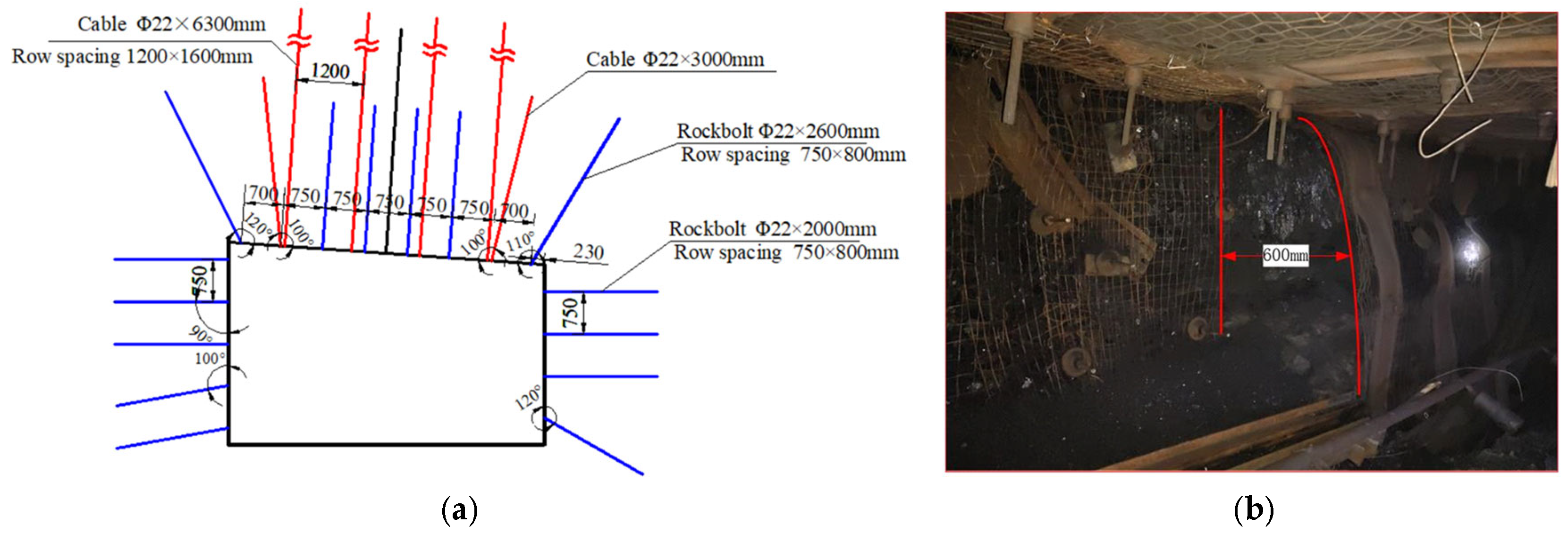
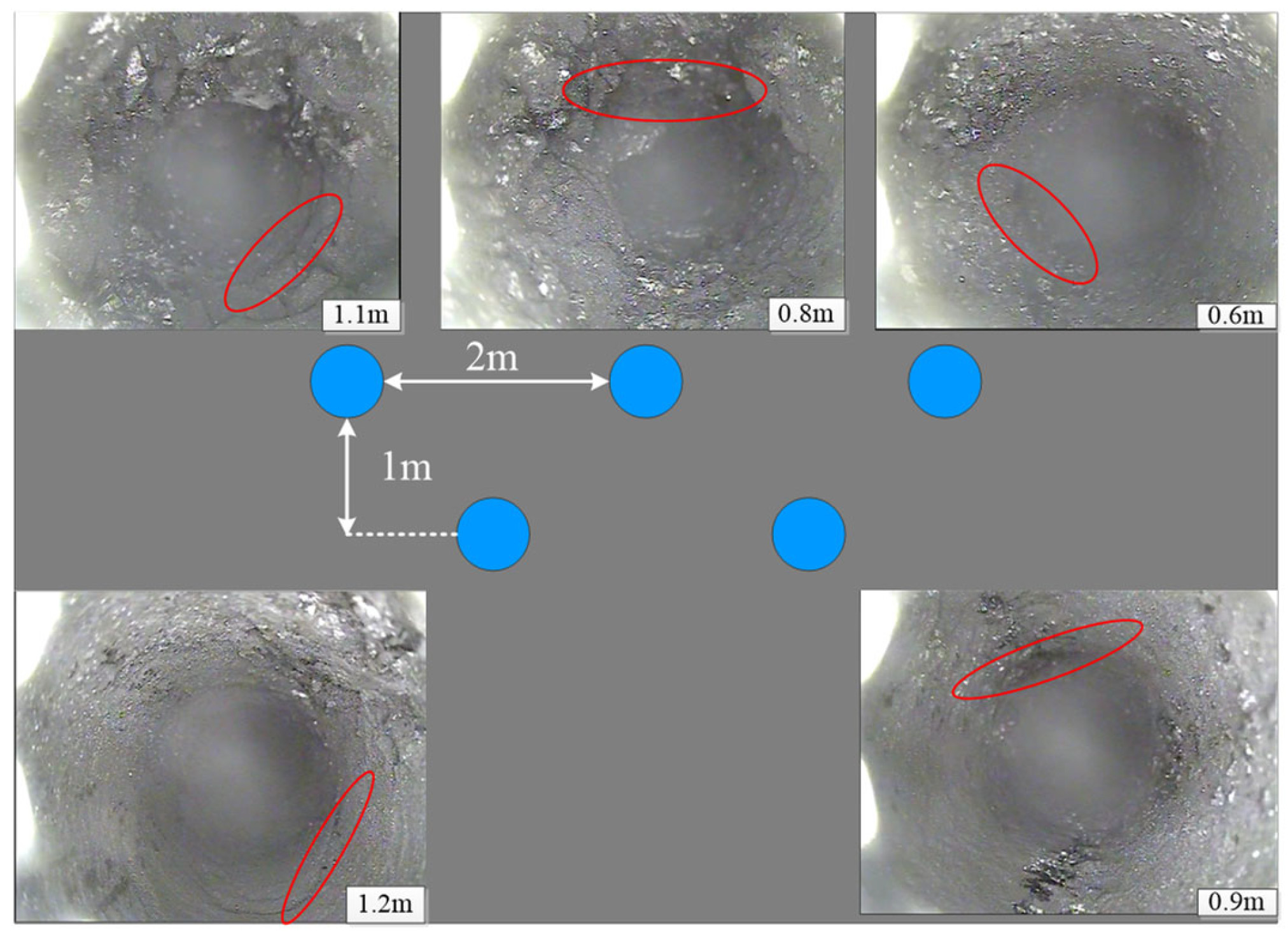
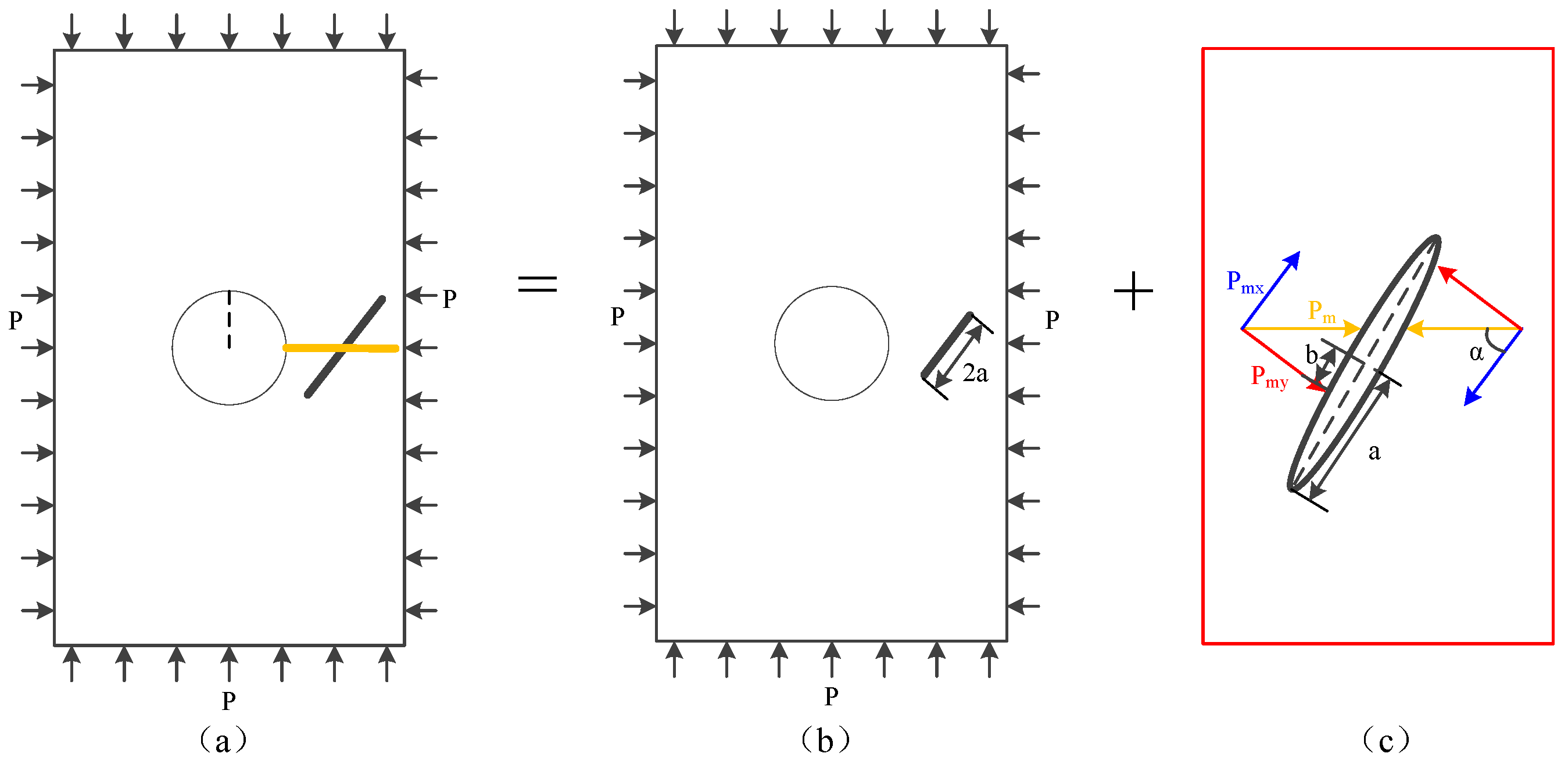
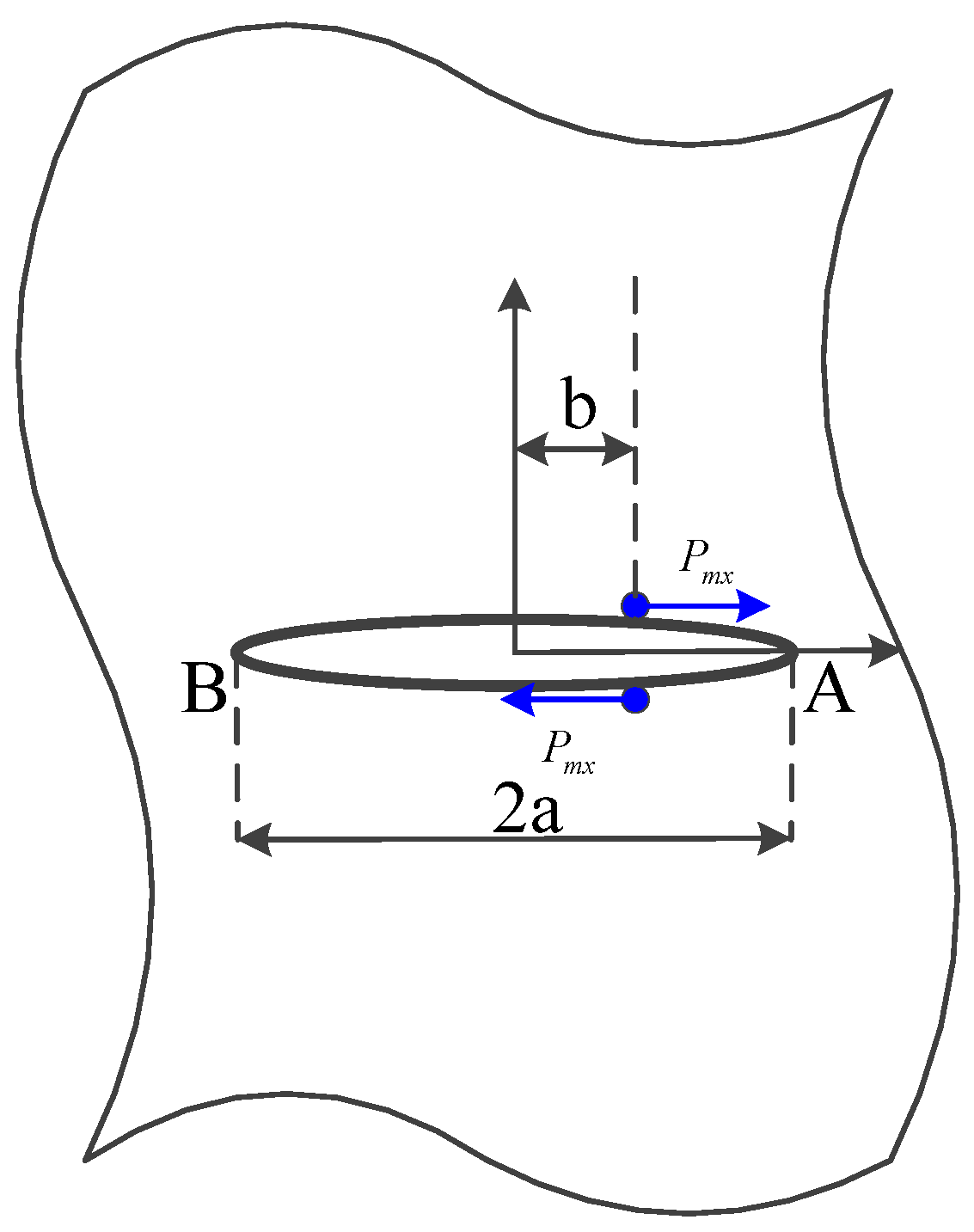
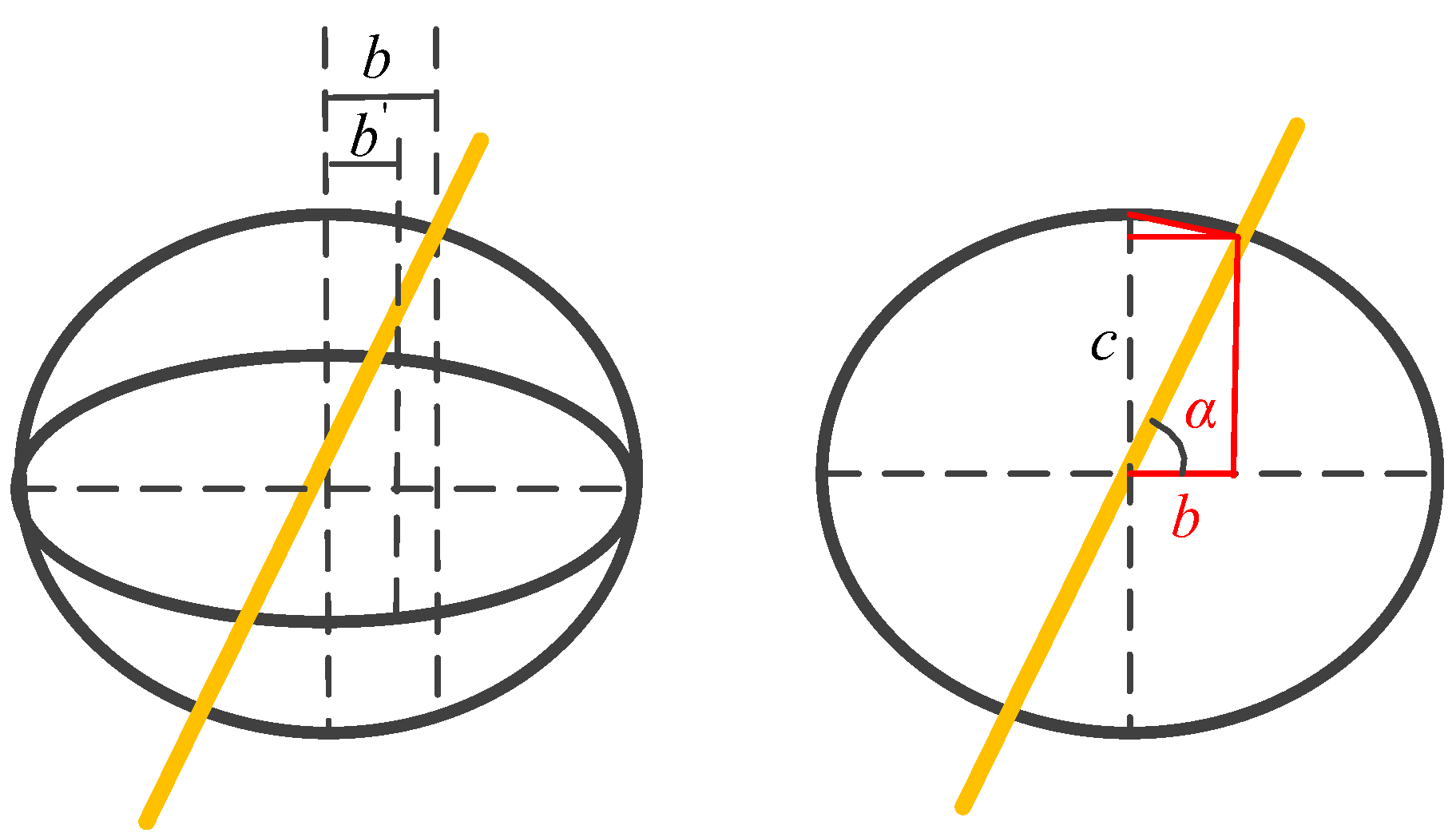

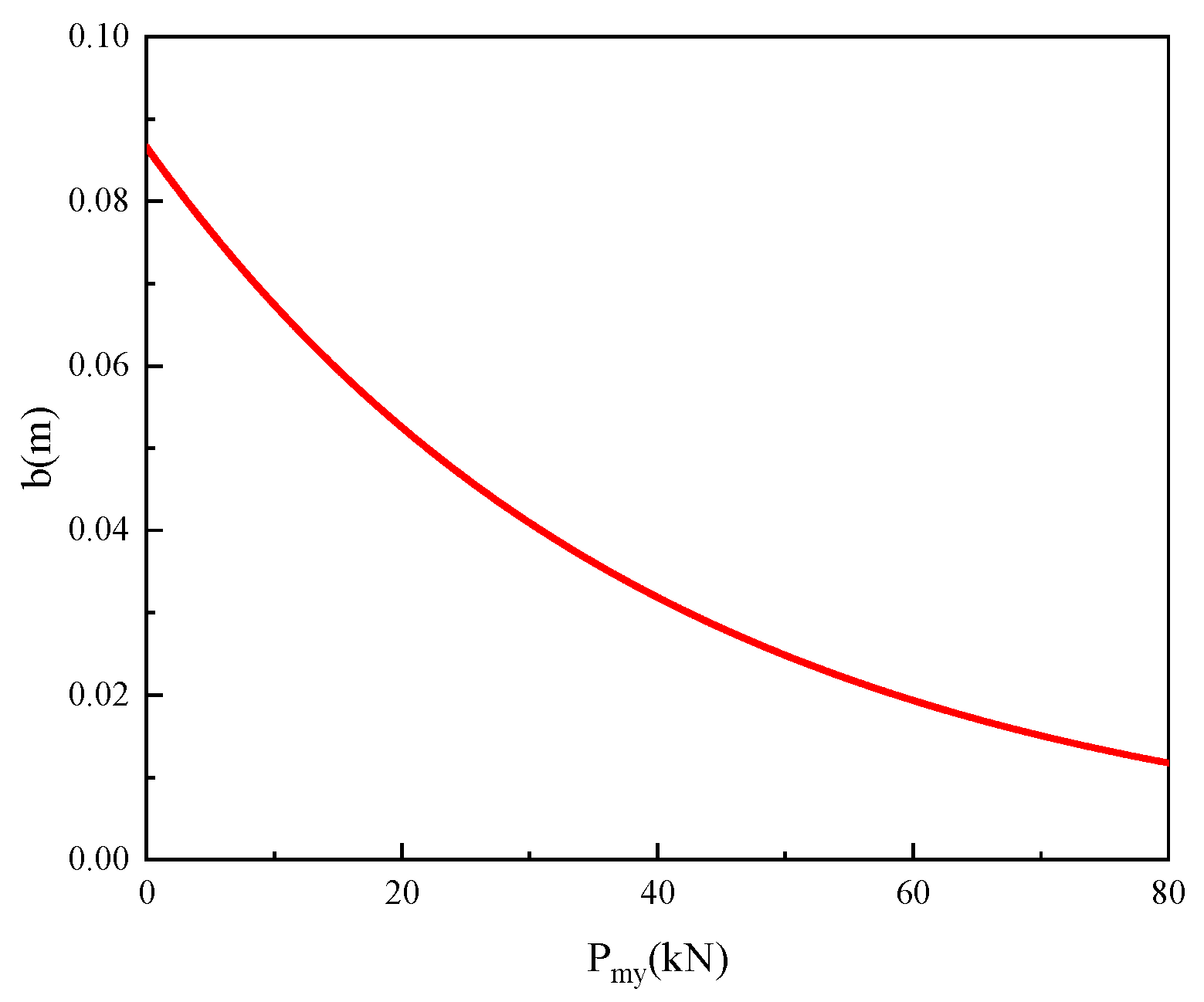
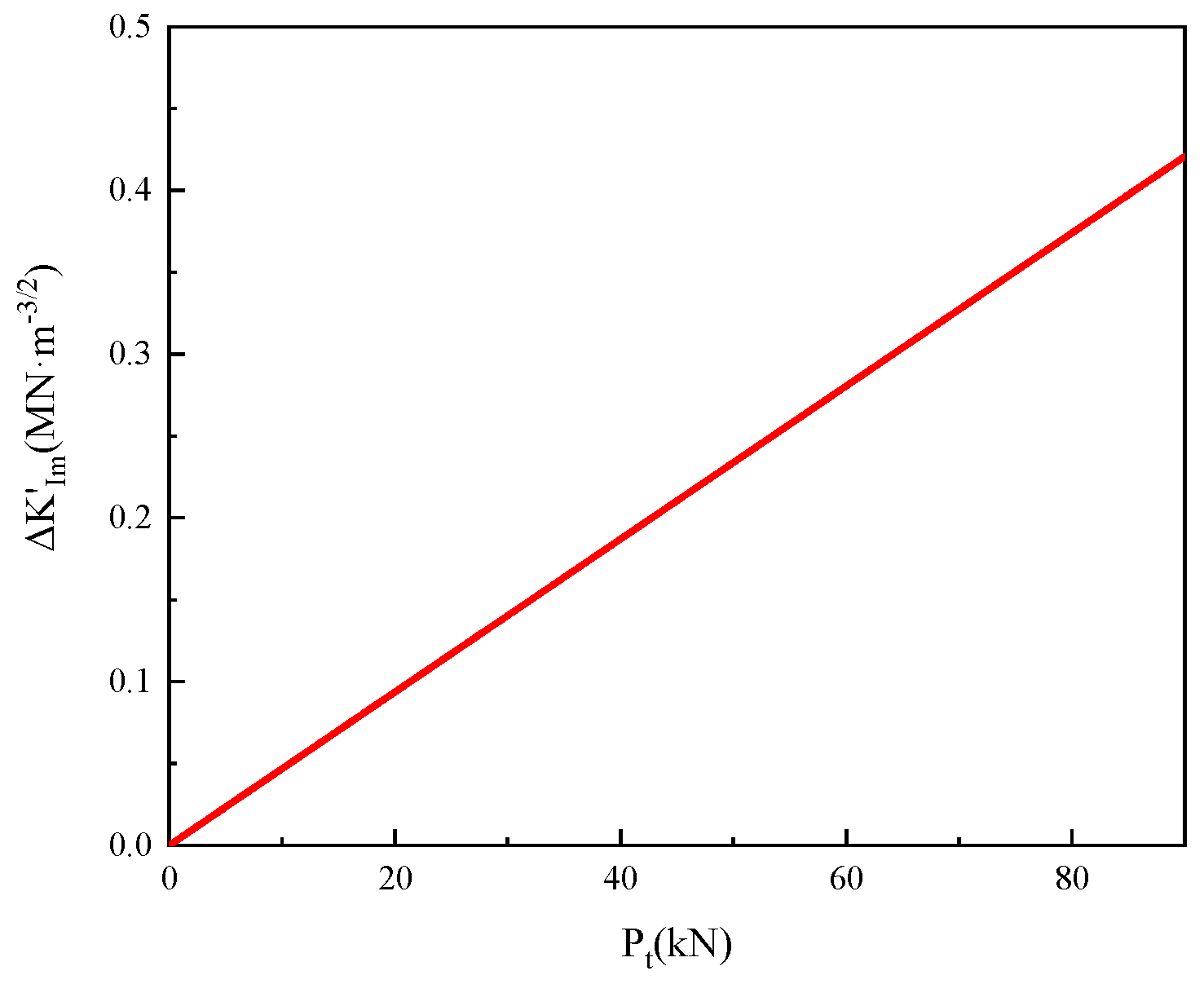
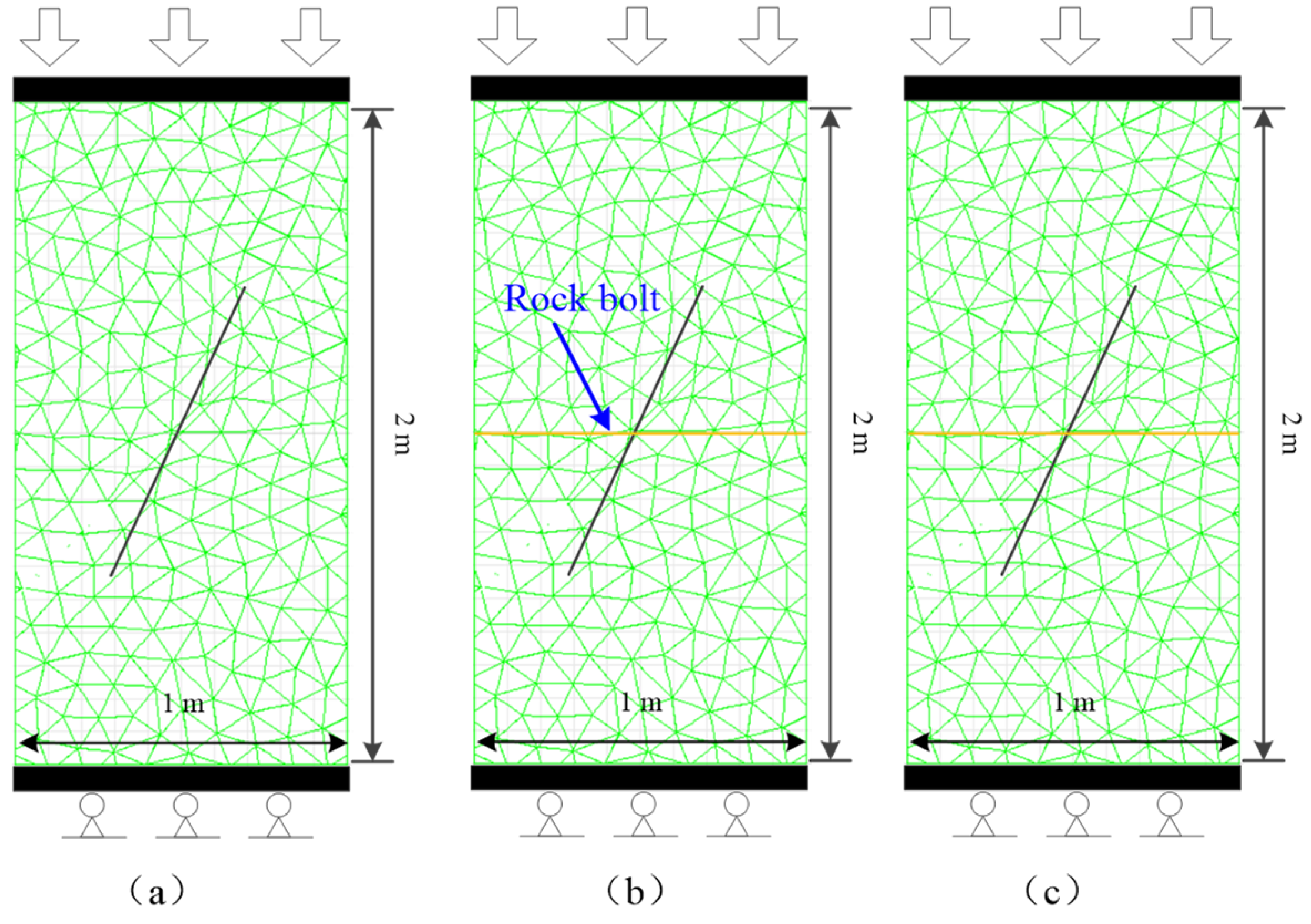

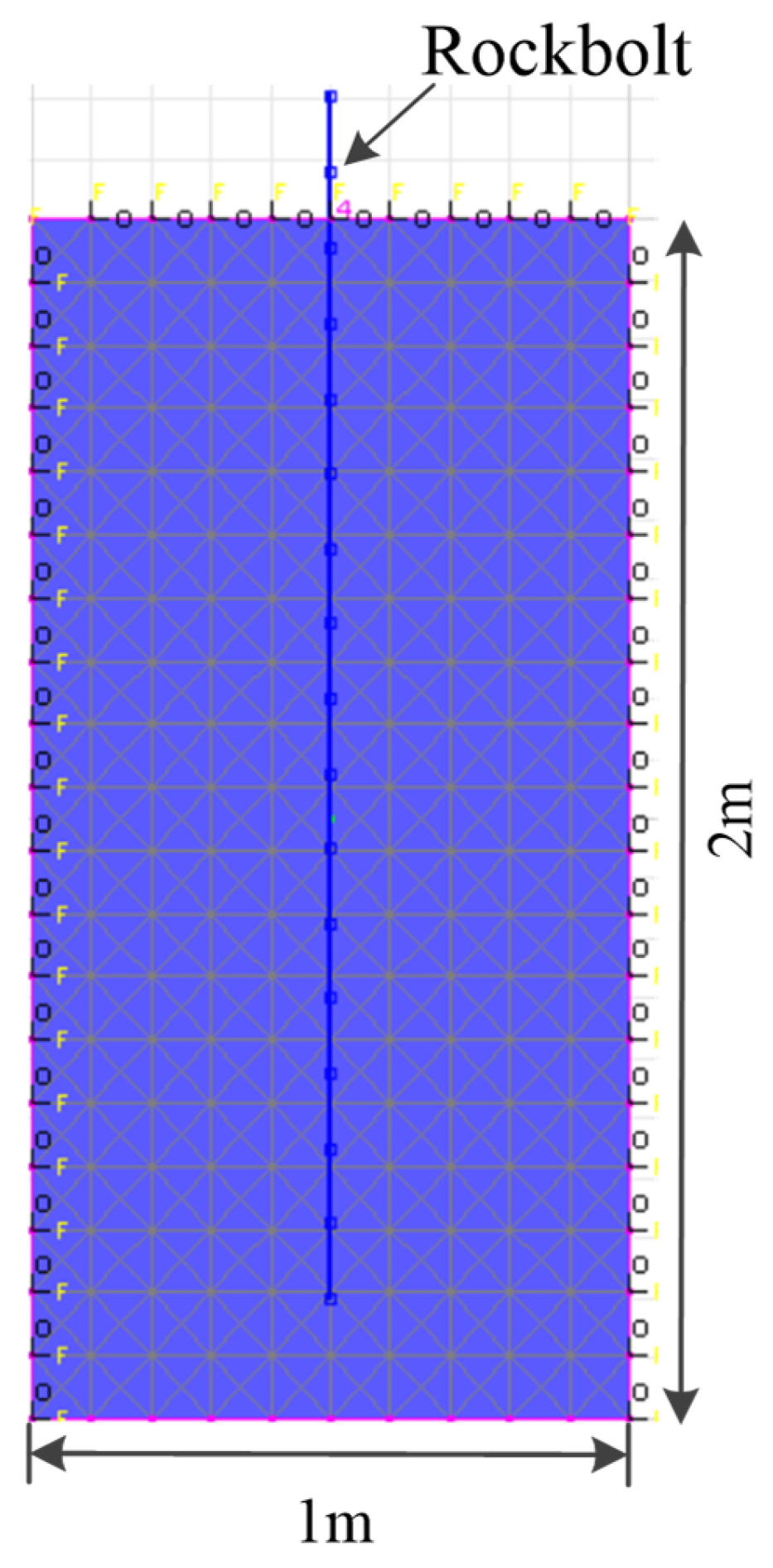


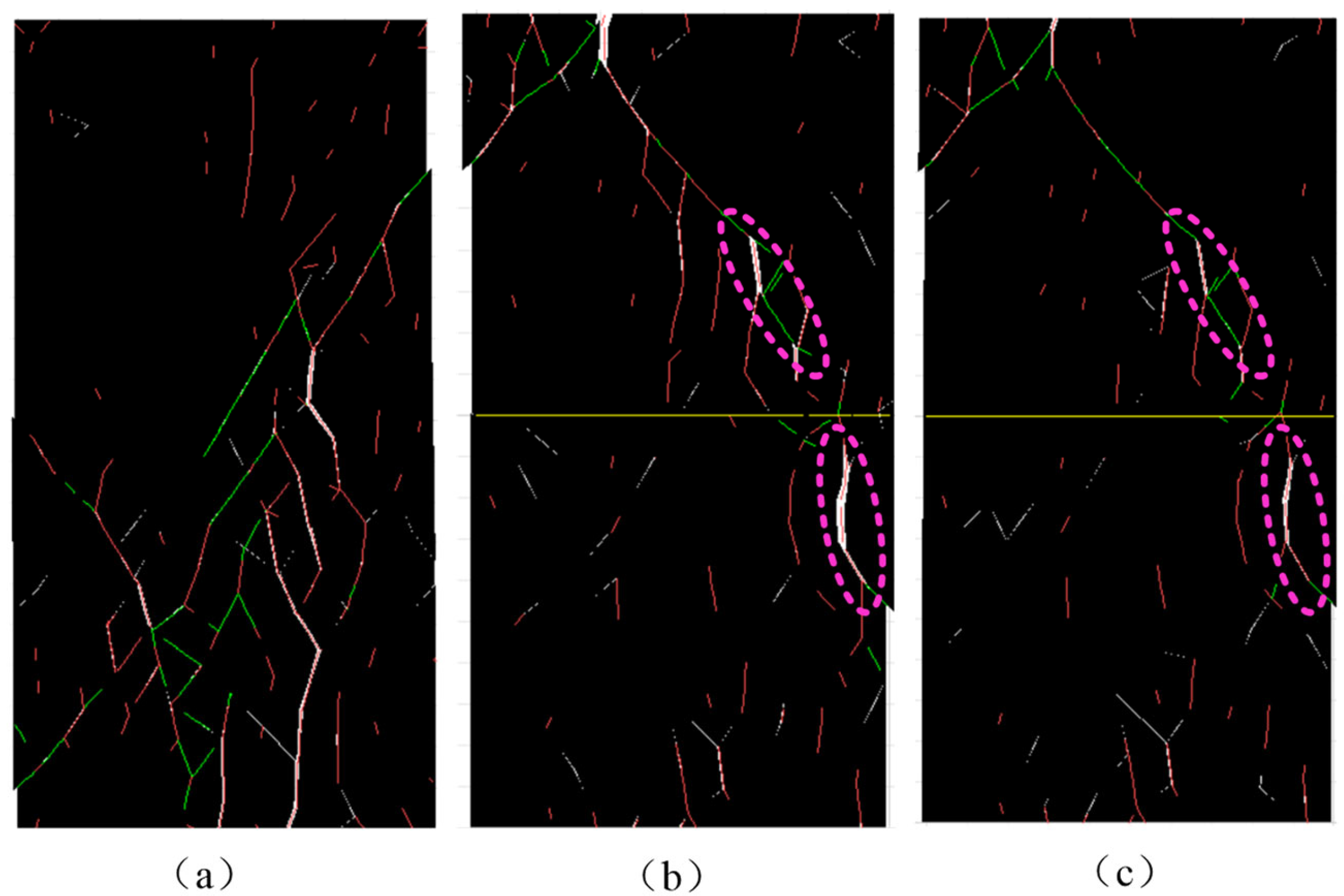


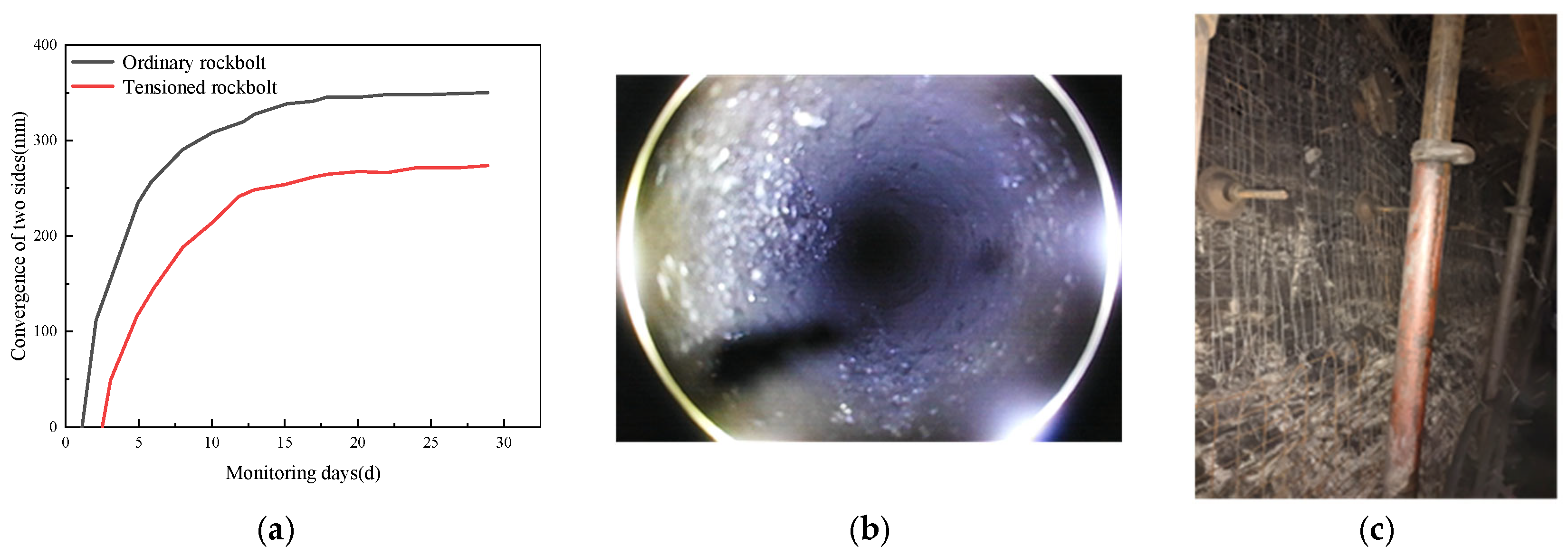
| General Parameters | Value |
|---|---|
| Elastic modulus of rockbolt/GPa | 200 |
| Elastic modulus of rock/GPa | 1.8 |
| Poisson’s ratio of rock | 0.25 |
| Radius of rockbolt/mm | 11 |
| Length of rockbolt/m | 2.8 |
| Angle between rockbolt and crack/° | 60 |
| Normal stiffness of crack/(GPa·m−1) | 200 |
| Shear strength of crack/MPa | 2 |
| Friction angle of crack/(°) | 30 |
| Cohesion of crack/MPa | 1 |
| Short semi-axis of crack/m | 0.1 |
| Distance from hole mouth/m | 0.1 |
| Long semi-axis of crack/m | 0.2 |
| Group | Pre-Tension (Load)/MPa | Loading Speed/(m·s−1) |
|---|---|---|
| 1 | 0 (without rockbolt) | 0.02 |
| 2 | 0.105 | |
| 3 | 0.237 |
| Category | Density/ (kg·m−3) | Bulk Modulus/ GPa | Shear Modulus/GPa | Cohesion/ MPa | Friction Angle/(°) | Tensile Strength/MPa |
|---|---|---|---|---|---|---|
| Block | 1800 | 1.2 | 0.72 | 6.3 (εp = 0) | 26 | 1.2 |
| 4.9 (εp = 0.002) | ||||||
| 0.2 (εp = 0.005) | ||||||
| Contact surface | Normal stiffness/ (GPa·m−1) | Tangential stiffness/ (GPa·m−1) | Cohesion /MPa | Friction angle/(°) | Tensile strength/MPa | |
| 216 | 86.4 | 3.8 | 17 | 1.2 |
| Cross-sectional area/(m2) | Elastic modulus/GPa | Yield limit/ kN | Moment of inertia of the cross-section/(m4) | Failure strain limit | |||
| Rockbolt | 3.8 × 10−4 | 200 | 128 | 1.2 × 10−8 | 0.15 | ||
| Exposed perimeter/m | Cohesive strength of tangential coupling spring/MPa | Stiffness of tangential coupling spring/ (GPa·m−1) | Friction angle of tangential coupling spring/(°) | Cohesive strength of normal coupling spring/MPa | Stiffness of normal coupling spring/ (GPa·m−1) | Friction angle of normal coupling spring/(°) | |
| Anchoring parameters | 0.07 | 1 | 8 | 45 | 200 | 20 | 0 |
| Without Anchoring | Low Pre-Tension | High Pre-Tension | Change Rate/% | |
|---|---|---|---|---|
| Damage degree/% | 52.1 | 49.1 | 43 | −5.7 |
| −17.4 | ||||
| Number of shear cracks/count | 1063 | 936 | 823 | −11.9 |
| −22.6 | ||||
| Number of tensile cracks/count | 112 | 91 | 64 | −18.8 |
| −42.9 |
Disclaimer/Publisher’s Note: The statements, opinions and data contained in all publications are solely those of the individual author(s) and contributor(s) and not of MDPI and/or the editor(s). MDPI and/or the editor(s) disclaim responsibility for any injury to people or property resulting from any ideas, methods, instructions or products referred to in the content. |
© 2024 by the authors. Licensee MDPI, Basel, Switzerland. This article is an open access article distributed under the terms and conditions of the Creative Commons Attribution (CC BY) license (https://creativecommons.org/licenses/by/4.0/).
Share and Cite
Wu, B.; Chang, J.; Wang, X.; Shi, W.; Li, C.; Chen, D. Research on the Mechanism and Application of High Pre-Tension on the Crack-Arresting Effect of Rockbolt Anchorage. Buildings 2024, 14, 2584. https://doi.org/10.3390/buildings14082584
Wu B, Chang J, Wang X, Shi W, Li C, Chen D. Research on the Mechanism and Application of High Pre-Tension on the Crack-Arresting Effect of Rockbolt Anchorage. Buildings. 2024; 14(8):2584. https://doi.org/10.3390/buildings14082584
Chicago/Turabian StyleWu, Bowen, Jucai Chang, Xiangyu Wang, Wenbao Shi, Chuanming Li, and Dingchao Chen. 2024. "Research on the Mechanism and Application of High Pre-Tension on the Crack-Arresting Effect of Rockbolt Anchorage" Buildings 14, no. 8: 2584. https://doi.org/10.3390/buildings14082584
APA StyleWu, B., Chang, J., Wang, X., Shi, W., Li, C., & Chen, D. (2024). Research on the Mechanism and Application of High Pre-Tension on the Crack-Arresting Effect of Rockbolt Anchorage. Buildings, 14(8), 2584. https://doi.org/10.3390/buildings14082584







